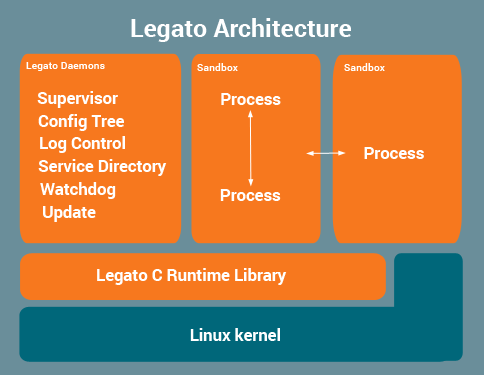Runtime Architecture
Legato's runtime architecture manages each app in its own sandbox.

Apps communicate with each other using access-controlled message-passing services.
The Supervisor automatically creates sandboxes.
Applications
An application (we call them 'apps') is a collection of executable files, libraries, and/or other resource files (e.g., audio files, web pages) that can be deployed to a target device. Once installed on a device, an app can be started and stopped.
By default, each app runs in its own sandbox. When an app is constructed, all the files and IPC services it needs to access are declared. At runtime, the Supervisor and the Service Directory enforce that only approved files and IPC services are accessed by that app.
Supervisor
The Supervisor is a privileged process running on the target device that:
- creates and destroys conceptsSecuritySandbox for apps
- starts and stops apps
- performs fault recovery when apps fail (e.g., restarting the app).
Service Directory
Legato's Service Directory provides a secure way for client processes to find servers offering services they need, which ensures only authorized connections are established.
Config Tree
The Config Tree provides persistent basicConfig data storage organized in a tree structure.
Command line config tool
Config Tree API
Watchdog
Legato provides a monitoring service for applications with the watchdog daemon which runs within the Legato Runtime Environment. If your target supports it, the watchdog daemon can also be enabled to kick an external watchdog such as Linux watchdog device.
- Note
- To configure the external watchdog kick interval, add a externalWatchdogKick section to your systems System Definition .sdef .
The daemon monitors app's processes for hangs or freezing and if the process doesn't "kick" the watchdog daemon in a specified time (the default is 30 seconds), the watchdog signals the Supervisor to perform a specified action. Critical services should also set the maxWatchdogTimeout to further ensure that the system is running with all critical services started.
- Note
- Most platform services installed on your target have a maxWatchdogTimeout set to 2 minutes. To enable, configure or disable watchdog on a platform service, configure the watchdog settings in the platform service's Application Definition .adef.
The watchdog consists of 3 configurable settings:
- timeout: the time the watchdog daemon waits for a "kick" in normal operation.
- maxTimeout: the maximum time the watchdog daemon waits for a kick (including on startup, when performing a system recovery, and after le_wdog_Timeout()).
- action: the action the watchdog daemon takes when it does not receive a "kick".
All settings are configured in the app's definition file (.adef). You must also bind the watchdog API into your app and use the Watchdog Service API's functions to configure the behavior of the watchdog and the app.
- Note
- Setting the maxTimeout also ensures the watchdog is started on system boot (rather than the first instance of
le_wdog_Kick()).
Default watchdog kick timeout: 30 seconds
Default watchdog action: restart
Possible watchdog actions:
ignore- Supervisor just logs a warning message; no further action taken.restart- log a critical message and restart the process.restartApp- log a critical message and restart the entire app.stop- Supervisor terminates the process if it's still running.stopApp- log a critical message and terminate the entire app (send all processes the SIGTERM signal, followed shortly by SIGKILL).reboot- log an emergency message and reboot the system.
To disable the watchdog for all the daemons within the Legato Application Framework remove the two "#" symbols from the watchdog build section in Makefile.framework.
The command has already been added to the mkexe arguments for liblegato, but has been commented out. Remove the "#" from the following line and the line above it: --cflags=-DLEGATO_FRAMEWORK_WDOG_DISABLE
Example:
.PHONY: watchdog
watchdog: liblegato $(BIN_DIR)
mkexe $(LOCAL_MKEXE_FLAGS) \
-i $(LEGATO_ROOT)/framework/liblegato \
-i $(LEGATO_ROOT)/framework/liblegato/linux \
$(SRC_DIR)/watchdog/watchdogDaemon #\ #uncomment the \
#--cflags=-DLEGATO_FRAMEWORK_WDOG_DISABLE #uncomment this line
To disable the watchdog for the Platform Services on your target set LEGATO_SERVICES_WDOG_DISABLE=1 within the buildVars section of your System Definition .sdef .
Logs
Legato provides a user-friendly way to control log message filtering for running app processes.
Command line log tool
Logging API.
Update Daemon
The Update Daemon accepts update pack files that contain software/firmware update instructions and associated data like libraries, executables, and resource files.
Update packs can be fed to the Update Daemon through the Update API API or through the update tool.
The Update Daemon includes hooks that allow update packs to be digitally signed and/or encrypted for security reasons.
Copyright (C) Sierra Wireless Inc.
